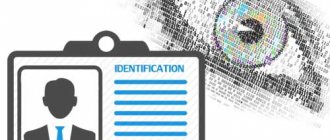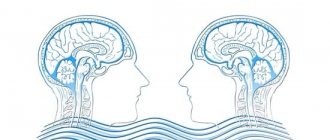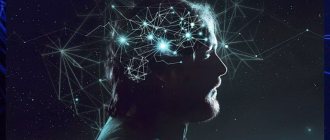Personal identification is a concept in psychology, which is considered as the identification of an individual with another, more significant or whole group, character from a literary work, film, etc. Often, by the word “identification” psychologists mean a defense mechanism in which a person unconsciously becomes like someone who causes fear and anxiety.
Identification in psychology
Identification in psychology
is considered as a natural process, unconscious or only partially conscious. Identification allows you to quickly and successfully adapt to society, promotes personal development and allows you to communicate easily.
As a psychological defense mechanism, identification occurs at an unconscious level. A person resorts to using projections associated with another, significant person. Identification is realized through the attribution of feelings and personal qualities inherent in another person.
What is identification: definitions
What is this? Identification is in psychology the process of an individual’s imitation of another subject, group, fictional character (image); the process of self-identification of an individual with a group, image, or another person. Identification is, in simple words, the search for an answer to the question “Am I the same as who?”
The term was introduced by S. Freud. The psychologist examined the phenomenon within the framework of psychoanalysis. The first thing Freud studied was the child’s identification with one of the parents. At the same time, the researcher came to the conclusion that identification is always based on fear and anxiety. By identifying with a stronger, more authoritative person, the individual reduces the discomfort he experiences.
However, a little later the author identified several types of identification:
- primary (child with mother);
- identification with a loved one (“I want to be like you”);
- identification with an unloved person (a defense mechanism of the psyche, “you will not offend someone like yourself”);
- identification in the perception of community (“stand in my place”, “what would he do”, “what would he think”).
Over time, the concept began to be used in a broader sense. According to him, personal identification is imitation, emotional fusion with someone. However, some psychologists still adhere to the psychoanalytic theory, arguing that it is a defense mechanism developed by evolution that helps in adaptation. Let's take a closer look at modern definitions and find out what identification means in psychology.
Identification
The meaning of the word "identification"
The name is derived from the Latin indentifico, which means “to identify.” Identification is the establishment of correspondence, similarity between two or more objects.
Identification concept
According to definitions from various dictionaries, identification is:
- identification, recognition of objects (encyclopedic dictionary);
- comparison with a standard, identification for litigation (business dictionary);
- subconscious identification of oneself with another person, often a parent (psychiatric dictionary);
- a psychological defense mechanism in which an individual becomes like his offender and identifies himself with him (psychological dictionary);
- a protective mechanism of the psyche, in which a weak person adopts the experience and features of a strong person (psychological dictionary).
In sociology, identification is understood as the process of an individual identifying himself with some group, another person. This is clearly visible in the example of youth subcultures. An individual copies the external attributes, behavior, values, beliefs, and interests of the group.
See also: PSYCHOPHISIOLOGY - directions and tasks
History of discovery and study
The concepts of “defense mechanisms” and “identification” were introduced into psychological science by Sigmund Freud. According to his interpretation, identification is:
- a defensive reaction that occurs against the background of fear of punishment for aggressive behavior or sexual attraction;
- unconscious identification of the subject with another against the background of fear of loss of love.
In psychoanalytic teaching, identification is considered as the only mechanism contributing to the formation of personality. Through unconscious identification, the child reproduces the parental image.
In behaviorism, identification is considered as a mechanism for the formation of social roles. It is associated with the need to reinforce secondary needs.
Development mechanism
Identification develops in several stages. The first occurs at the age of about 3 years, when the child begins to understand that he and his mother are not one whole, that another person is vying for the mother’s attention - the father. The child cannot compete with him for his mother, so he needs to develop paternal qualities in himself. This will allow later, already in adulthood, to win a “mother” - a woman who will become a companion.
The second stage of identification development occurs during adolescence. The period of separation is the time when a teenager moves more and more away from his parents and is left alone with the big world. To find external support, he needs another person or group with which to identify.
In the process of identification, a person gains new experience, acquires qualities that later help him determine his own vector of development. With the help of identification, a young child develops personal characteristics and behavioral patterns, and begins to understand his gender identity. Focusing on a meaningful image helps to overcome the feeling of one’s own weakness and inferiority.
Information Systems
In this area, to identify means to assign a certain identifier to a subject or object. It could be a barcode or a password in a particular system. The action of comparing objects with a list of identifiers is also called. Authorization of users on sites occurs almost simultaneously with the process of establishing personal identity. Which leads to confusion of these concepts. It should be understood that on ordinary information sites the user logs in, that is, goes online and gets access to commenting on materials. But for portals where financial payments take place, it is important to identify the person. This means that the system needs to establish whether the action is actually carried out by that particular living person, with last name, first name, passport, who is the owner of the account.
Structure and functions
Identification occurs gradually. In the structure of the formation of this psychological defense mechanism, the following stages are distinguished:
- a connection arises with an important object on an emotional level, “trying on” the feelings of another person to oneself occurs;
- perception of an important object as oneself - the most striking features of another (an object to be imitated), his style of behavior, manner of speaking, spiritual values, beliefs, life guidelines, interests are integrated into the personality;
- own personal characteristics are assigned to a significant object. Your desires and feelings are attributed to a dear person.
Identification performs an adaptive function - an individual “takes” the traits of another person (or group) in order to be like him, to feel that he belongs to a clan.
Identification is a means that helps you immerse yourself in the world of another person, understand his thoughts and feelings.
Science, art and forensics
In chemistry, to identify is to establish an identity between an unfamiliar compound and an already known one. This word has the same meaning in other scientific fields, where experiments are carried out comparing various objects, figures, numerical values, formulas and phenomena. Even in art, identification is sometimes used. It is necessary if, for example, it is necessary to establish the authorship of a work. In this case, scientists carry out a comparative analysis of things written by a writer, poet, composer or artist, and based on the data they identify with them or reject the controversial creation. In forensic science, to identify means to identify a person or his things by comparing existing facts (signs) with unchangeable ones inherent in a particular person. These can include photographs, voice recordings, DNA, fingerprints, blood tests, and others.
Kinds
According to the psychoanalytic approach, a person can form a positive or negative identification. In the first case, the object is the one towards which the subject experiences predominantly positively colored emotions.
In the case when negative self-identification occurs, the object whose characteristics are assigned by the subject is viewed as an aggressor, a person who causes fear and anxiety.
There is also primary and secondary identification. The primary one is formed during the interaction of a person at an early age with a parent of the same sex. For a girl, the mother becomes the object, for a boy, the father becomes the object.
Secondary identification is formed on the basis of the child’s interaction with other people who are present nearby.
Several other subtypes of identification are considered in psychology.
Situational
In adults, this type of identification is updated when interacting with other, more significant adults, for example, during work meetings with subordinates or when meeting a new person. Children use this defense mechanism when playing together with peers in order to become like them. The function of this type of identification is to be as similar as possible to the currently significant person.
Group
This type of psychological defense is considered very stable. It is characterized by the fact that a person shares the moral values, views and foundations of the reference group, being in it and outside it.
In some cases, group identification appears only in certain situations - when a person is within a group. If he is outside the group, his views and behavior change, and his own prevail.
Cultural
Identification occurs through identification with the culture of a particular society. A person is well aware of his own potential and accepts the requirements of the society of which he is a part.
Social
A person realizes that he is an important element of society. He believes that his belonging to a certain group is very important, that he can represent values and protect the interests of the community.
Personal
A person identifies himself only with himself. He is aware of his own uniqueness and is not afraid to demonstrate it. This type of identification differs from others in that a person has a single system of views, beliefs, goals and interests. An individual’s belonging to any social group does not cancel his stable ideas about himself and does not change the set of his personal characteristics.
Collectivist
A defense mechanism is formed in a team member. When colleagues engage in joint activities, they transfer emotions to each other. Gradually, a common emotional background, mutual assistance, and sympathy are formed in the team. Participants in the collective process try to help their colleagues, share the joy of the successes achieved and the hardships associated with each other’s failures
Sexual
Formed in the first years of life. At the age of 2-3 years, the baby begins to show interest in his own body and associate himself with a certain gender.
Gender
It manifests itself through awareness of gender (it is not always identical to gender). Gender identification allows a person to understand who he feels like (a woman or a man).
Identification concept
Identification is a mechanism, the basic basis for the functioning of which is the emotional contact of a person with the people around him (parents), which leads to an unconscious assimilation to them.
This is the identification of personal character traits, one’s own feelings, thoughts, external data with similar characteristics of other individuals.
Types of identification
Identification can be divided into several types, depending on the field of activity or its application.
- Personal. Detection and preservation of an unchangeable personal principle.
If a person is able to draw a parallel between this permanent core and his own person, then he is destined not to get lost in the plurality of roles he plays.
- Social. A citizen identifies himself with representatives of a specific group of people, taking into account his social sympathies, life hobbies and common problems.
The reason for the need for social identification is a person’s deep-seated need for self-realization, recognition from others, receiving approval from society and collective protection. By identifying his individual with specific communities, a person can explain “why does he consider this particular group to be his?”
- Unconscious. This type of identity is determined by the following criteria: considering himself a member of a certain group, a citizen, at the same time, demonstrates qualities that characterize representatives of another society.
- Partial. The manifestation of this type of identity is possible with multi-group membership.
In this case, a person perceives himself as a representative of several groups (professional, sports, family).
- Direct. The implementation of this kind of identity occurs through a society close to the one to which the citizen subjectively identifies himself, although for some reason he does not belong to it.
- Language. The distinctive features of languages have become a reflection of significant differences between the cultures of peoples.
Differences in behavior and language may appear when in contact with citizens of different status, or representing an external or internal group of a person.
Under the influence of culture, the social context of the use of certain words changes. For example, peoples whose language provides for the absence of the pronoun “I” when speaking, as a rule, are distinguished by greater collectivization.
- Political. The socio-political basis of this type of identity implies several possible interpretations.
For example, the basis for the emergence of its ideological subtype is the cognitive components of consciousness, that is, it is a construct that reflects the socio-political worldviews, interests and aspirations of citizens.
Such identity becomes the basis for the formation of political beliefs and consolidation of the community.
- By religion. Religious affiliation directly influences the formation of national identity, namely, the definition of the ethnic group to which an individual belongs.
People, being Catholics, Orthodox, and Muslims, focus on their own belonging to a particular ethnic culture. Accordingly, religious identification replaces ethnic identification.
- According to biometric parameters. The basis for this type of identification of a citizen is his unique physiological and behavioral characteristics.
Its use is aimed at preventing access to the territory of a closed institution, to an ATM or computer.
Biometric properties are presented:
- facial geometry,
- fingerprints,
- iris,
- handwriting.
With the development of technology, new parameters appear.
- By DNA analysis. The objects for such analysis are DNA regions characterized by repeats in their own sequence.
- Based on appearance. Identification of this species solves problems associated with operational-search activities (identification of persons hiding from the law or missing, identification of individuals using verbally recorded or photographic images).
- By dental status. The need for this type of identification arises when unidentified corpses are discovered, that is, if it is not possible to identify the deceased by appearance.
- Banking. During transactions, the client is required by law to present a passport (this can also be identification documents: a military ID card, or an identity card temporarily issued to a citizen by internal affairs bodies).
- Legal basis.
It is divided:
- procedural, the reason for this type of identification is the criminal procedure code;
- not procedural, the reason for its implementation is operational investigative actions and compilation of forensic accounts;
- carried out by subjects;
- carried out according to the nature of the images (the image remaining in the memory of a witness or acquaintance;
- carried out based on evidentiary value (when it is established that some characteristic belongs to a specific person, for example, handprints or smell).
Stages
The first stage of identification formation, which occurs at an early age, is very important for personality development. Not only S. Freud, but also other classical psychologists insisted on this. In the first years of life, identification occurs under conditions of high emotional load, but it also becomes a necessary condition for further alienation and the formation of one’s own ideas about oneself as a person.
In the process of differentiation by the child of himself and isolation from others, his independence grows, he begins to better understand himself as a source of activity. The child learns to act differently from others.
Jung believed that identification is necessary for the development of personality at a stage when there is no individual path yet. As soon as the opportunity arises to follow the path of individual development, identification turns from a factor stimulating development into an obstacle to it. Identification at the stage when a person must take his own path provokes dissociation and prevents him from gaining integrity. Jung believed that identification is a very important stage that precedes individuation.
As a person matures, the importance of identification decreases, while alienation, on the contrary, increases and reaches its maximum level in adulthood. The exception is during periods when a person goes through an identity crisis.
Methods
Experimental methods of research in most cases focus on specific aspects - social roles, gender or group affiliation, personality characteristics. Such studies make it possible to identify the peculiarities of living certain identities and searching for a significant object for identification in different situations and areas of activity.
Difficulties arise when it is necessary to study not specific characteristics, but to form a holistic picture of the personality and its identity.
In order to explore the widest possible range of manifestations of identity, to understand with whom, with what and to what extent a person identifies himself, several diagnostic directions are used:
- Questionnaires to identify the level of attitude towards oneself and self-satisfaction. They are easy to use, easy to standardize and validate on a representative sample. Limitations to obtaining objective survey results may include cognitive biases related to self-perception, as well as socially desirable responses.
- Psychosemantic research methods - in them, the assessment of one’s own personality is considered through compliance with a certain set of criteria, which are not always socially approved.
- Projective techniques - they provide an opportunity to explore identity and self-awareness.











